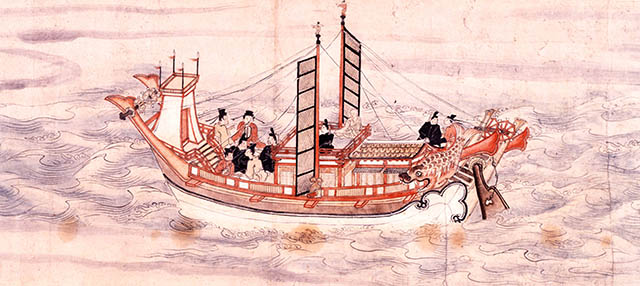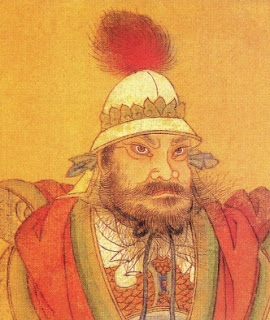The 13th Japanese mission to Tang China - As the first RJNO: Rescue of Japanese Nationals Overseas in 759
From 630 to 894, the imperial court of Japan send missions to Tang China with the intent to get Tang's knowledge, culture, and send student like a Fulbright Program in today. Those missions ride 4 ships and send 400 officials under the ambassador to Tang, students, and sailor ordinary.
 |
| The ship of Japanese mission to Tang China, painted in 1319 |
In history of 20 times missions, there is one singular event. The 13th mission in 759 was irregular in not only the head of mission named "the ambassador for rescuing ex-ambassador", but also they consisted 99 people and one ship, different from 400 people and 4 ships fleet in general case. Gendo Ko, the head of 12th mission, might be confused.
 |
| An Lushan, General of Agile Cavalry in Tang Dynasty, ringleader of the An Lushan Rebellion |
Why the imperial court of japan decided this eccentric mission? The answer may be that 13th Japanese mission to Tang China was not diplomat and student. They was a task force to rescue Japanese from rebellion in Tang China. In 755, An Lushan, Sogd Chinese and who was General of Agile Cavalry in Tang Dynasty, and he try a coup to Emperor Xuanzong of Tang.
 |
| Kiyokawa Fujiwara, a son of the northern family of Fujiwara clan, from the Japanese who's who book published in 1868 |
Kiyokawa Fujiwara, the ambassador of 12th Japanese mission to Tang China, was born as a son of the northern family of Fujiwara clan, most powerful family in Heian period Japan. And more, he was a smart official in both of these imperial court, Japan and China. In Japan, he was appointed as the member of council. For minister, faster promotion than his elder brother, by Empress Koken. Moreover, in Tang China, Emperor Xuanzong applauded a his personality. So, he was hard to replace for the imperial court of japan.
Gendo Ko, who had to rescue the bright son of Fujiwara, was official of intermediate rank in economic section. Why the economic official was assigned to Rescue of Japanese Nationals Overseas operation? Because, Ko family had Migrant origin. thus, the imperial court of Japan expected his knowledge of Northeast Asia,and linguistic ability, probably.
In February 759, Ko and his task force, as the 13th Japanese mission to Tang China, departed Japan and crossed the see of Japan. In general case of other mission, they ship to Tang China directly, or via Silla Korea. But then, Ko could not choice both because of the rebellion in China and deterioration of a relationship between Japan and Silla Korea. So, Ko chose a route via Balhae kingdom, a friendly nation of Japan, and taking passage in returning mission from Balhae.
 |
| Emperor Suzong of Tang, never let back Kiyokawa |
After arriving Balhae, Ko selected 10 men as task force going to Tang China with him, and the others send back Japan with vice-envoy Matanari Kura. Ko's squad entered into China in safety. But diplomatic negotiation was harder than deploying task force to China. Emperor Suzong of Tang prosed to exchange Kiyokawa for cow horn as material for bows.
Ko gave up negotiation and back to Japan with with Tang Chinese sailors escort. In Japan, he tried to collect horns as much as 7,800 merchant ships. But he wasn't in time for Kiyokawa dying while abroad. At long last, Kiyokawa, favorite of the imperial court of Japan, was raised to Junior First Rank after his death. And Gendo Ko who tried to take Kiyokawa home, was granted lower noble in Japan and appointed governor of Mikawa Province. It is still so difficult for this country to clear up "Rescue of Japanese Nationals Overseas" operation completely, but sustain efforts in today.


